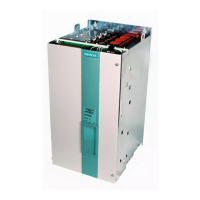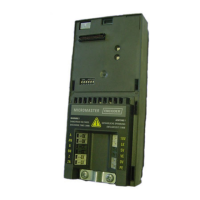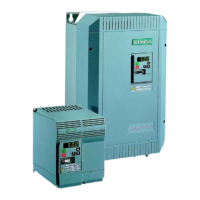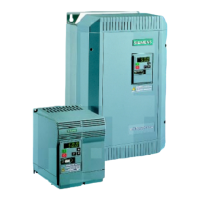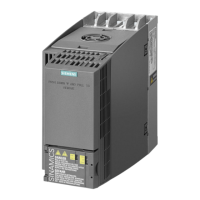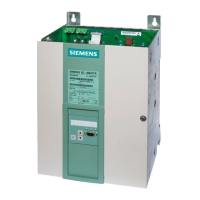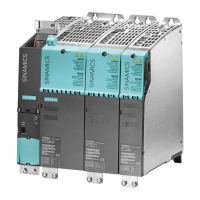G85139-E1740-U305-B
08.96
Siemens plc 1996
3
Press
Press
P
Press Change
P
Press Press Change Press
others
Press
PP?
?
N
Y
Y
N
[1] [2] [3] [5] [6] [8] [9]
[4] [7]
Notes
[1] Display changes to `P000'.
[2] Select the parameter to change.
[3] View the value of the parameter currently selected.
[4] Do you wish to change the value? If not, go to [6].
[5] Increase ( n ) or decrease ( o ) the value of the parameter.
[6] `Lock' the new value into memory (if changed) and return to the parameter display.
Note
To increase the resolution to 0.01 when changing frequency parameters, instead of pressing P momentarily to return to the parameter display, keep the button
pressed until the display changes to `- -.n0' (n = the current tenths value, e.g. if the parameter value = `055.8' then n = 8). Press n or o to change the value and
then press P twice to return to the parameter display.
[7] Do other parameters need changing? If so, return to [2].
[8] Scroll up or down until `P971' or `P000' is displayed. If you scroll upwards, the display stops automatically at P971. However, pressing the n button again causes the display to
`wrap around' to P000.
[9] Exit from the procedure and return to the normal operating display.
If parameters are changed accidentally, all parameters can be reset to their default values by setting parameter P944to 001 and then pressing P.
Fig. 5:Procedure for Changing Parameter Values
or
no
or
no
or
no
IMPORTANT: Parameters above P009 cannot be adjusted unless P009 is first set to 002 or 003.
OPERATING INFORMATION
General
The inverter does not have a main power switch and is therefore live when the mains supply is
connected. It waits with the output disabled for the RUN button to be pressed, or an ON signal
via terminal 5 or 6 (rotate right or left), or a RUN command from the serial link.
If output frequency (P001 = 0) is selected as the display, the corresponding setpoint is displayed
approximately every 1.5 seconds while the inverter is stopped.
The inverter is programmed at the factory for standard applications on Siemens four-pole
standard motors. When using other motors it is necessary to enter the specifications from the
motor's rating plate into parameters P081 to P085. Note that access to these parameters is not
possible unless P009 has been set to 002 or 003.
When delivered, the inverter's frequency setpoint is set to 0.00 Hz, which means that the motor
will not rotate! To make it start up, a setpoint must be entered using the n button or entering a
value in P005 or setting a setpoint via the analogue or serial interfaces.
When a parameter value has been set, it is stored automatically in the internal memory.
Basic Operation
The most basic method of setting up the inverter for use is described below. This method uses
a digital frequency setpoint and requires only the minimum number of parameters to be changed
from their default settings.
(1) Apply mains power to the inverter. Set parameter P009 to 002 or 003 to enable all
parameters to be adjusted (see Figure 5 for the procedure) .
(2) Set parameter P005 to the desired frequency setpoint.
(3) Press the RUN button( I ) onthe inverter's front panel. The inverterwill nowdrive the motor
at the frequency set by P005.
If required, the motor's speed (i.e. frequency) can be varied directly by using the no
buttons. (Set P011 to 001 to enable the new frequency setting to be retained in memory
during periods when the inverter is not running.)
Operation – Digital Control
(1) Connect control terminal 5 to terminal 1 via a simple on/off switch. This sets up the inverter
for clockwise rotation (default).
(2) Apply mains power to the inverter. Check that parameter P006 is set to 000 to specify
digital setpoint.
(3) Set parameter P007 to 000 to specify digital input and disable the front panel controls.
(4) Set parameter P005 to the desired frequency setpoint.
(5) Set P011 to 001 to enable the new frequency setting to be retained in memory during
periods when the inverter is not running.
(6) Set the external on/off switch to ON. The inverter will now drive the motor at the frequency
set by P005.
Operation – Analogue Control
(1) Connect control terminal 5 to terminal 1 via a simple on/off switch. This sets up the inverter
for clockwise rotation (default).
(2) Connecta 10 kΩ potentiometer to the control terminals asshown in Figure 4 orconnect a 0
- 10 V signal from pin 2 (0V) to pin 3.
(3) Apply mains power to the inverter.
(4) Set parameter P006 to 001 to specify analogue setpoint.
(5) Set parameter P007 to 000 to specify digital input and disable the front panel controls.
(6) Set parameters P021 and P022 to specify the minimum and maximum output frequency
settings.
(7) Set the external on/off switch to ON. Turnthe potentiometer (oradjust the analogue control
voltage) until the desired frequency is displayed on the inverter.
Stopping the Motor
Stopping can be achieved in several ways:
• Going down to 0.0 Hz (lowering the setpoint to 0.0 with the o button causes the motor to
come to a controlled stop in accordance with the selected ramp down rate (P003)).
• Cancelling the ON command, pressing the OFF button (O) on the front panel or setting the
external on/off switch to OFF causes the inverter to ramp down at the selected ramp down
rate (see P003).
• DC injection braking up to 250% causes an abrupt stop after cancellation of the ON
command (braking is controlled via P073).
• Compound braking (braking is controlled via P066).
If the Motor Does Not Start Up
If the motor does not start up when the ON command has been given, check that the ON
command is valid, check if a frequency setpoint has been entered in P005 and check that the
motor specifications have been entered correctly.
If the inverter is configured for operation via the front panel (P007 = 001) and the motor does not
start when the RUN button is pressed, check that P121 = 001 (RUN button enabled).
If the motor does not run after parameters have been changed accidentally, reset the inverter to
the factory default parameter values by setting parameter P944 to 001 and then pressing P.
Remote Control
The inverter can be controlled remotely via a USS data line connected to the serial interface
terminals. If full remote control is required, parameter P910 must be set to 1.
Up to 31 inverters can be connected to an external control unit. Each inverter can be addressed
individually by allocating a slave address (P091) to it.
EUROPEAN LOW VOLTAGE & EMC DIRECTIVES
European Low Voltage Directive
The MICRO MASTER Junior product complies with the requirements
of the Low Voltage Directive 73/23/EEC.
The units are certified for compliance with the following standards:
EN 60204-1 Safety of machinery - Electrical equipment of machines
EN 60146-1-1 Semiconductor converters - General requirements and line commutated
converters
European Machinery Directive
The MICRO MASTER Junior inverter series does not fall under the scope of the Machinery
Directive. However, the products have been fully evaluated for compliance with the essential
Health & Safety requirements of the directive when used in a typical machine application. A
Declaration of Incorporation is available on request.
European EMC Directive
When installed according to the recommendations described in the operator's handbook, the
MICRO MASTER Junior fulfils all requirements of the EMC Directive as defined by the EMC
Product Standard for Power Drive Systems IEC 22G-WG4 (CV) 21.
Artisan Technology Group - Quality Instrumentation ... Guaranteed | (888) 88-SOURCE | www.artisantg.com
